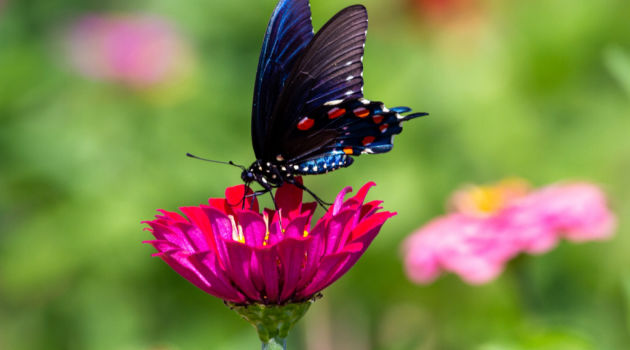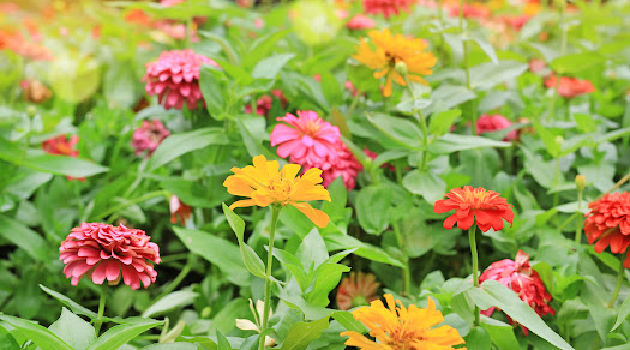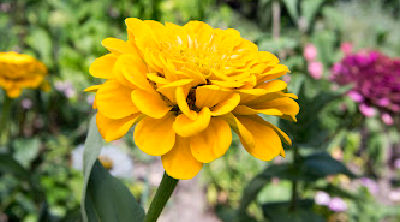Zinnia plants enjoy wild popularity among gardeners all around the world.
But why do they have such a great claim to fame? Mainly–the dazzling displays of colors and shapes. They come in various colors, and their blooms can be shaped like stars, balls, or tubes.
Zinnias make great cut flowers for decorating indoors or outdoors, lasting well as dried flower arrangements if you grow them from seed!
In this article, we’ll talk about how to grow and care for these beautiful true annuals all season long.
Planting Zinnias
Zinnia plants can easily grow from seeds, either planted directly into a sunny flower bed or in a pot.
They’re usually susceptible to transplant shock, which is why you will have be best luck if you grow them from seed.
However, if you choose to start the seeds indoors, be sure to use a pot made from something that will decompose easily, like peat pots or any other biodegradable container that can be directly planted into the garden at a later time.
Initiate your seed-starting process four to six weeks before your area’s last frost date.
Fill the pot or container with soil and sprinkle zinnia seeds over its surface; cover them lightly with more mix. Keep moist at all times during germination until you see tiny leaves poking out of the soil.
In about 14 to 21 days, you should see your zinnias germinated.
Outdoors, zinnias will begin their actual growth when temperatures rise above fifty degrees or so.
Space the plants about twelve inches apart to allow for plenty of sunshine and air circulation.

Soil for Planting Zinnia Plants
Zinnias need well-draining soil to survive and thrive.
Use garden compost or potting mix, which contains a good amount of organic material, for the best results.
The soil should be free from weeds, rocks, sticks, and other debris before planting them in it.
Light
Zinnia plants need at least six hours of direct sunlight per day to bloom.
If you’re growing them indoors, place the pot near a window that receives plenty of natural light for optimum blooming conditions.
You can also supplement with artificial lighting, such as grow lights if needed.
Zinnia Care
Once you succeed at growing flourishing blooms, take these steps to care for your plants.
Watering
Keep soil moist; zinnias need a moderate amount of water.
Be careful not to over-water as this can lead to root rot, killing the plant off completely.
Water once every few days or whenever the soil feels dry and uncomfortably hard to touch with your fingers.
Fertilizing
Zinnias need plenty of nitrogen-rich fertilizer to encourage new shoots and root growth during the first few months after they are planted.
The best time for fertilization is just before you plant them outdoors in your flower bed or pot.
Thereafter, it’s a good idea to fertilize them every month with a balanced fertilizer.
Weeding around Zinnia Plants
Zinnias need plenty of room to spread and grow, so they’ll need a weed-free bed to thrive.
When you are weeding around zinnias, be sure not to pull the plants up by their roots; instead, gently dig them up with your hands or use an old spoon if necessary.
Pruning
Zinnias are usually grown as annuals, so they will need to be pruned when their flowers fade and die off—to encourage new growth from the plant’s root crown.
If you’ve planted your zinnia outside, this should be done around the end of September.
If you’ve planted your zinnia indoors, prune them after their last flower has bloomed and withers away—to encourage new growth.
Add a dusting of an organic fertilizer onto the soil every spring before planting or transplanting if desired.
Be sure not to use fertilizers that have heavy salt or nitrate content.
Overwintering
Zinnias are a plant of the sun and can’t handle cold temperatures.
If you live in an area hit by severe winters, it’s recommended to dig up your zinnia plants from their current location and bring them indoors (such as into storage containers) before the first frost arrives.
You will want to replant them in the spring once temperatures are consistently above 50 degrees F.

Pests and Diseases That Can Harm Zinnia Flowers
Zinnias are susceptible to various pests such as aphids, spider mites, slugs, snails, and caterpillars.
You can use an insecticidal soap spray or organic neem oil around the leaves to get rid of these pesky critters.
If aphids are a persistent problem, you may need to use a more heavy-duty pesticide.
Collembola can also cause problems for zinnias, and feeding on the roots of these plants is their primary means of annoyance. To control this pest, mix liquid soap with water in equal proportions; spray around the base and along the plant’s leaves to kill them.
Zinnias can also get infested with powdery mildew, which will cause yellowing of the leaves and flowers, as well as a white or greyish film on the plant’s surface.
To prevent this from happening, make sure to water your plants during dry periods and avoid overhead watering using drip irrigation systems.
When it comes to pests and diseases, prevention is key.
Growing Zinnias from Cuttings
Other than growing from seeds (which is much easier and inexpensive), you can propagate zinnias using cuttings or by division.
Cuttings
Take a cutting from the plant and insert it into moist soil to allow roots to form before transplanting or leave it in water until new shoots appear.
This is an easy method for increasing your stock of plants if you’re trying to keep them inside during the winter months.
Division
Divide the plant in early spring for an easy and quick way to multiply zinnias without much effort involved.
Simply dig up a clump of soil containing at least three or four plants, dividing them into individual sections with their roots intact before returning to the ground.
Success rate: The success rates vary depending on the type of zinnia, but around 50% is a good estimate.
 The Bottom Line on Growing Showy Zinnia Flowers
The Bottom Line on Growing Showy Zinnia Flowers
If you’re looking for a beautiful, low-maintenance flower to add color and life to your outdoor space this summer, look no further than zinnia plants.
Zinnias are easy to care for because they grow well in sunny areas with average soil conditions.
They come in many different colors, so something will suit every garden style and taste.
With their short blooming cycles, zinnia flowers can be planted early spring or late fall, which means that you won’t have to wait long before seeing them start growing!
These colorful beauties also make great cut flowers if you don’t want the hassle of keeping up with watering all season long.
With zinnias, you can have the best of both worlds!

 The Bottom Line on Growing Showy Zinnia Flowers
The Bottom Line on Growing Showy Zinnia Flowers